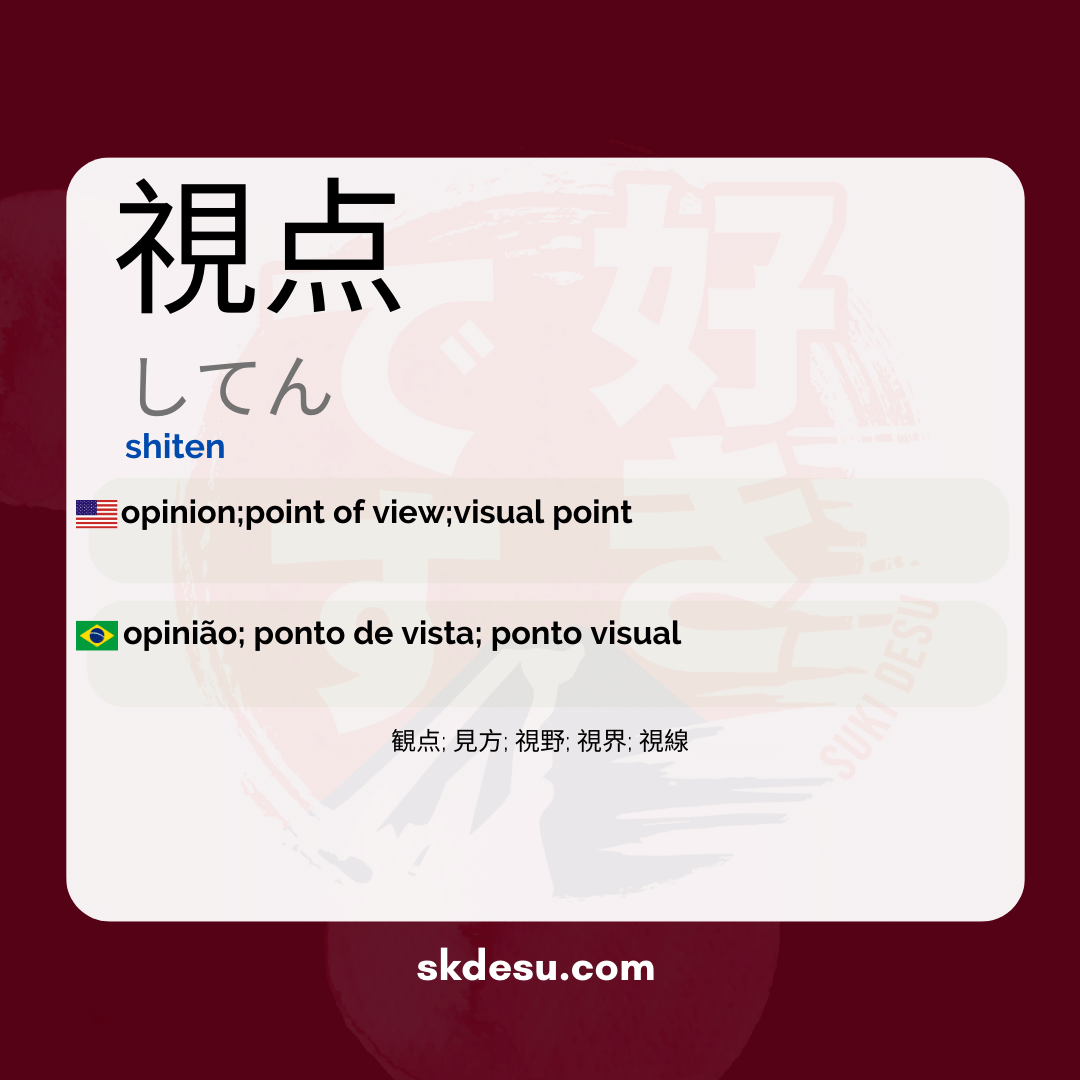Translation and Meaning of: 視点 - shiten
The Japanese word 視点[してん] (shiten) is a fascinating term that carries important nuances in both the language and Japanese culture. If you are studying Japanese or simply interested in the language, understanding its meaning, origin, and use can enrich your knowledge. In this article, we will explore everything from the composition of the kanji to everyday situations where this word appears, along with practical tips for memorization.
In addition to being useful for students, 視点 also reveals interesting aspects of the Japanese mindset, especially when we analyze how it is employed in discussions and texts. Whether in casual conversations or in more formal contexts, knowing this word can open doors to a deeper understanding of the language. Let's start by uncovering its basic meaning and then move on to topics such as etymology and examples of usage.
Meaning and composition of 視点
視点 is formed by two kanji: 視 (shi), which means "vision" or "sight," and 点 (ten), which can be translated as "point" or "aspect." Together, they create the concept of "point of view" or "perspective." This word is often used to describe the way someone perceives a situation, idea, or problem. Unlike simple opinions, 視点 implies a more structured or well-founded analysis.
It is worth noting that 視点 does not limit itself to just literal views. In contemporary Japanese, it also encompasses philosophical, artistic, and even scientific perspectives. For example, in academic debates, it is common to hear phrases like 「彼の視点は興味深い」 (kare no shiten wa kyōmi bukai) – "His point of view is interesting." This flexibility makes the word widely used in different contexts.
Origin and Evolution of the term
Although it is made up of ancient kanji, 視点 as a consolidated word emerged in modern Japanese, mainly from the Meiji period (1868-1912). During this time, Japan began to import Western concepts related to critical analysis and discussion of ideas, which required more precise terms for "point of view." 視点 was one of the words that gained strength in this context, being adopted in academic and journalistic texts.
Interestingly, the kanji 視 has older roots, appearing in classical Chinese with the meaning of "to observe closely." While 点, although simple, conveys the idea of something specific or focused. This combination reflects well the current meaning of the word: not just to look, but to focus on a particular aspect. Throughout the 20th century, 視点 became even more common, especially in discussions about art, politics, and sociology.
How to use 視点 in daily life
One of the best ways to reinforce 視点 is to apply it in real situations. In conversations, it can be used to ask for or give opinions, such as in 「あなたの視点を教えてください」 (anata no shiten o oshiete kudasai) – "Please tell me your point of view." This type of phrase is common in work meetings or debates, where different perspectives are valued. Note that 視点 sounds more formal than simply 意見 (iken, "opinion"), so it’s better to use it in structured contexts.
Another interesting use appears in art or literary criticism, where 視点 describes the perspective of the author or artist. For example, in a museum, you might hear phrases like 「この絵の視点はユニークだ」 (kono e no shiten wa yunīku da) – "The point of view of this painting is unique." This usage shows how the word goes beyond everyday contexts, entering the field of creative analysis. For students, paying attention to these details helps memorize not just the term but also its cultural application.
Tips for memorizing 視点
An effective way to remember 視点 is to associate its kanjis with concrete images. Since 視 contains the radical 見 (miru, "to see"), it already suggests something related to vision. On the other hand, 点 can be linked to "focal point" or "detail." Thinking of the word as "the point where the gaze is placed" makes assimilation easier. This technique is especially useful for those who are starting to study kanjis and want to build solid mental connections.
Another practical tip is to consume content where 視点 appears frequently, such as opinion articles, documentaries, or discussions in Japanese forums. By seeing the word in various contexts, your brain will naturally memorize it more easily. If you use apps like Anki, creating cards with real sentences (instead of loose translations) can also speed up learning. Remember: the key is repeated and meaningful exposure to the term.
Vocabulary
Expand your vocabulary with related words:
Synonyms and similar words
- 観点 (Kanten) - Perspective, point of view; generally related to an analysis or opinion.
- 見方 (Mikata) - Way of seeing or perceiving; it can refer to a more personal or subjective interpretation.
- 視野 (Shiya) - Field of vision; the ability to perceive or understand something in a broader context.
- 視界 (Shikai) - Visibility, the area that can be seen; often related to visual conditions or limitations.
- 視線 (Shisen) - Direction of gaze; specifically refers to where someone is looking or focusing.
Related words
Romaji: shiten
Kana: してん
Type: noun
L: jlpt-n1
Translation / Meaning: opinion; point of view; visual point
Meaning in English: opinion;point of view;visual point
Definition: A position or way of seeing things.
Quick Access
- Vocabulary
- Writing
- Sentences
How to Write in Japanese - (視点) shiten
See below a step-by-step guide on how to write the word by hand in Japanese. (視点) shiten:
Example Sentences - (視点) shiten
See below some example sentences:
Shiten wo kaeru koto de atarashii hakken ga aru
Changing the point of view can lead to new discoveries.
There is a new discovery by changing the point of view.
- 視点 (shiten) - point of view
- を (wo) - object particle
- 変える (kaeru) - change/alter
- ことで (koto de) - through
- 新しい (atarashii) - new
- 発見 (hakken) - discovery
- が (ga) - subject particle
- ある (aru) - exist/have
Other Words of this Type: noun
See other words from our dictionary that are also: noun

